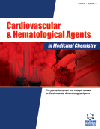- Home
- A-Z Publications
- Cardiovascular & Hematological Agents in Medicinal Chemistry (Formerly Current Medicinal Chemistry - Cardiovascular & Hematological Agents)
- Previous Issues
- Volume 14, Issue 1, 2016
Cardiovascular & Hematological Agents in Medicinal Chemistry (Formerly Current Medicinal Chemistry - Cardiovascular & Hematological Agents) - Volume 14, Issue 1, 2016
Volume 14, Issue 1, 2016
-
-
Role of Hydrogen Sulfide in Systemic and Pulmonary Hypertension: Cellular Mechanisms and Therapeutic Implications
More LessAuthors: Joshua Brampton and Philip I. AaronsonThere is increasing interest in the possible therapeutic benefits of the gasotransmitter hydrogen sulfide (H2S; sulfide), and drugs which release sulfide are currently being evaluated in both preclinical and clinical studies as treatments for conditions ranging from cancer to cardiovascular disease to inflammation. Sulfide is generally considered to act as a vasodilator, and it is therefore not surprising that the effects of sulfid Read More
-
-
-
Oxidative Stress Genes, Antioxidants and Coronary Artery Disease in Type 2 Diabetes Mellitus
More LessAuthors: Miha Tibaut and Daniel PetroviĦ#141;The worldwide increasing prevalence of obesity and sedentary lifestyle is the main cause of the rising incidence of T2DM. Due to chronic macrovascular and microvascular complications, T2DM represent a huge socioeconomic burden in the world. Oxidative stress is a key pathogenic mechanism implicated in diabetic coronary artery disease (CAD). Polymorphisms of oxidative stress genes are known to influence oxidat Read More
-
-
-
Comparison of Clinical Outcomes Following Single versus Multivessel Percutaneous Coronary Intervention Using Biodegradable Polymer Coated Sirolimus-Eluting Stent in an All-comers Patient Population
More LessBackground: Drug-eluting stents (DES) have been shown to reduce the rate of acute complications and the need for subsequent revascularization in cases where single-vessels are treated. The performance of DES in patients with multivessel disease and complex lesions, however, remains controversial. This study assessed and compared clinical outcomes following single vs. multivessel percutaneous coronary intervention ( Read More
-
-
-
Can Erythrocyte Catalase Regulate Blood Pressure?
More LessAuthors: Yury Kaminsky, Elena Kosenko and Gjumrakch AlievThis study investigated the effect of antihypertensive therapy with lisinopril on plasma cholesterol concentration and erythrocyte catalase activity in hypertensive patients. We observed, for the first time, significant inverse correlations between systolic blood pressure (BP) and erythrocyte catalase activity and between diastolic BP and erythrocyte catalase activity. Plasma total and low density lipoprotein (LDL) cholesterol as Read More
-
-
-
Pharmacological Evidence of α -adrenergic Receptors in the Hypotensive Effect of Chamaemulum nobile L.
More LessAuthors: Mohamed Hebi, Mohamed Ajebli, Naoufel A. Zeggwagh and Mohamed EddouksThis study aims to evaluate the underlying mechanism of action involved in the hypotensive effect of Chamaemulum nobile L. (Cn) aqueous extract on anesthetized Wistar rats. Lyophilized aqueous extract was administered in the jugular vein, arterial blood pressure and heart rate were measured in the carotide artery over 120 min of injection throughout an invasive direct blood pressure measuring procedure. Intraveno Read More
-
-
-
Hematological and Serological Investigation of Dogs during Experimental Echinococcosis
More LessAuthors: Aitbay Bulashev, Orken Akibekov, Sadybek Tokpan, Shynar Serikova and Gulmira AbulgazimovaObjectives: To study the hematological findings of dogs infected with echinococcosis and the possibility of using in vitro reared Echinococcus granulosus excretory-secretory antigen (ES-Ag) as a reagent for serological diagnosis of canine echinococcosis. Methods: Eight dogs were infected orally with protoscoleces, extracted from ovine fertile hydatid cysts. Two additional dogs were infected with Cysticercus tenuicollis, obtai Read More
-
-
-
Tapentadol PR for Pain Syndromes in Real Life Patients with Hematological Malignancy
More LessAuthors: Gregorio A. Brunetti, Giovanna Palumbo, Giacomo S. Morano, Erminia Baldacci, Ida Carmosino, Giorgia Annechini, Romina Talone, Sara Kiflom, Giada Mastrogiacomo, Sara Grammatico, Marta Chisini, Adriana Costa, Andrea Tendas, Laura Scaramucci, Marco Giovannini, Pasquale Niscola, Maria T. Petrucci and Claudio CartoniBackground: More than 50% of oncohematological patients suffer from pain syndrome, mostly originating from the bone, which often include nociceptive and neuropathic complaints. Tapentadol, a recently available treatment option for cancer pain, exerts a dual analgesic mechanisms (opioid and noradrenergic), allowing for a high clinical efficacy as well as for a reduction in adverse events compared to traditional opioi Read More
-
Volumes & issues
-
Volume 23 (2025)
-
Volume 22 (2024)
-
Volume 21 (2023)
-
Volume 20 (2022)
-
Volume 19 (2021)
-
Volume 18 (2020)
-
Volume 2 (2020)
-
Volume 17 (2019)
-
Volume 16 (2018)
-
Volume 15 (2017)
-
Volume 14 (2016)
-
Volume 13 (2015)
-
Volume 12 (2014)
-
Volume 11 (2013)
-
Volume 10 (2012)
-
Volume 9 (2011)
-
Volume 8 (2010)
-
Volume 7 (2009)
-
Volume 6 (2008)
-
Volume 5 (2007)
-
Volume 4 (2006)
Most Read This Month
Article
content/journals/chamc
Journal
10
5
false
en


